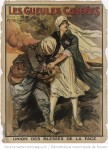
In France, almost 2.8 millions of people were wounded, 300 000 of whom were maimed, during the First World War. It is only at the end of the Great War that the term « Gueules Cassées » appeared. It is attributed to Colonel Picot, who was severely wounded on the face by a shell on January 15th, 1917. A few months later, Picot, who was withdrawn from the front, went to Paris, in place de la Sorbonne, to attend a patriotic celebration. Dissatisfied that he was since he could not enter, he mumbled : “gueule cassée” as a sign of protest. That is how the term was born. The face is often considered as “le lieu le plus humain des Hommes”. However, the official recognition of these disabled veterans took time.
It was during the American Civil War, 1861-1865, that for the first time, the wounded in combat were immortalised and began to be identified thanks to the medical photography present on the battlefield. At the beginning of the 20th century, during the First World War, 40% of the French quota was physically harmed and 11% to 14% of these disabled people were wounded in the face. Nevertheless, from 1919, Georges Clemenceau, the President of the Council, invited five representatives of the Gueules Cassées to the Treaty of Versailles. Is it the recognition of the war wounded ? This invitation is not representative of the treatment of the Gueules Cassées. These people wounded to the face do not have the right to get a disability allowance just like the other wounded soldiers because they came back from the battlefield with both of their arms and legs. Moreover, there are only a few testimonies written by the war wounded of the Great War and the few existing representations are not representative of the reality of the dismemberments. When the photos of the Gueules Cassées were seen by the population, it was first in newspapers and through political war propaganda (in L’Illustration or Le Miroir). The associative posters, such as academic artists, gave themselves over to almost approximative representations of the disabled soldier, and did not show a classic portrait, with a whole and realistic representation of the body, sometimes wounded.
In France, in 1921, posters were stuck up in the streets to support the Gueules Cassées and to recognize their status as disabled veterans. Colonel Picot, the founder of L’Union des Blessés de la Face et de la Tête, participated to this event. The organisation orchestrated on its posters a famous war couple : the wounded and the nurse. But the association was only recognized as a public interest in 1927, two years after the mention of “disfiguration” in the decree enabling the official recognition of these disabled veterans. During the following decades, the Gueules Cassées swung into action in order to speed up the process of recognition, particularly through associations.
The combatants’ facial wound is so important, on one hand quantitatively regarding the number of maimed soldiers back from the front and on the other hand regarding the consequences on the faces, that the medical sphere and more specifically the surgery had to evolve after the war to adapt to this new challenge. Apart from a few rhinoplasties - nose jobs - and otoplasties - ear jobs - already existing in the health field during the 19th century, plastic surgery was born in France in the days after the Great War when the Gueules Cassées wished to find back a “human face”. The needs rapidly became important during the war and the wounded were taken care of by centres specialised in maxillofacial surgery, away from the front. From this point forward, beyond the repair, surgeons, dentists but also doctors had to take into consideration the beauty of their patients. The “face sculptor” thus became an “artist”. But after the war, the demobilisation stopped the movement of specialisation that began during the five years of conflict. The return to normal life put an end to the new surgical field, and, in the manner of the military hospital of the Val-de-Grâce in Paris, the specialised health services put in place during the war closed their doors.
If they did not die in front, the Gueules Cassées did have psychological after-effects and undeniable physical wounds visible by the rest of the society. The awareness of the existence of these combatants wounded to the face allowed a mobilisation of the politicians, a larger recognition of the war wounded but also the creation of specific fields in medicine.
Read more in the dictionary : The Blind
References :
Sophie Delaporte, Visages de guerre : Les gueules cassées, de la guerre de Sécession à nos jours, Belin, 2017.
Claire Maingon, Mains coupées sur paupières closes : Blessures, mutilations subies et sublimées des artistes en guerre (1914-1930), Presses universitaires de Rouen et du Havre, 2018.
To quote this paper : Gautier Chancé, "Gueules cassées" in Hervé Guillemain (ed.), DicoPolHiS, Le Mans Université, 2021.